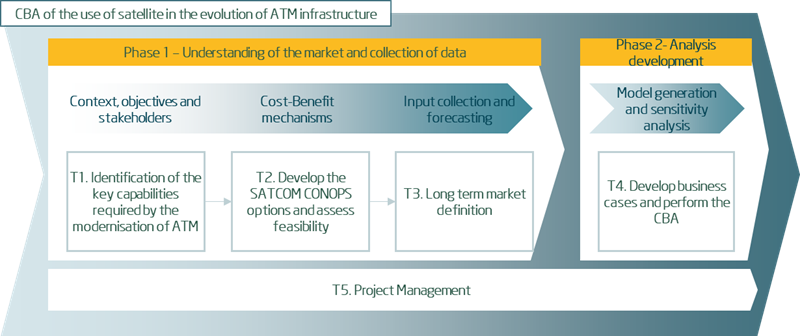-
StatusCompleted
-
Status date2020-02-14
-
Activity Code1B.125
The project has the ultimate objective of providing stakeholders with a comprehensive CBA of different future satellite solutions for Air Traffic Management (ATM). The goal is to provide actors with the relevant technological and economic benefits of satellite solutions and its associated costs, to incentivise their development and accelerate the modernisation of the ATM systems. The project activities are focused on:
- Satellite as a key pillar for Communication, Navigation and Surveillance services modernisation, supporting automation, connectivity and digitalisation
- Satellite for autonomous drones, providing ATM and command and control
- Satellite for a high-capacity, affordable data link that provides increased connectivity for both safety and non-safety purposes
To support the development of the CBAs and the identification of promising business cases, the project portrays the main characteristics of the sector, including main stakeholders, current business models, entry barriers, size of ATM market in terms of users and revenues and key drivers for ATM modernisation. It also identifies gaps & opportunities, taking into account the technological trends, spectrum & regulatory issues and the expected evolution of the ATM services.
One of the challenges of the project is to identify innovative and high-potential satellite concepts of operations that can be attractive for stakeholders and a major contribution to the modernisation of ATM, while being feasible from a regulatory, technological and economical point of view. Another challenge is to assess costs and benefits of proposed business cases adequately, given the focus on the long-term and its associated uncertainties.
The main benefit of the project is to provide the stakeholders with the relevant technological and economic benefits of satellite solutions and its associated costs, in order to incentivize their development and accelerate the modernisation of the ATM systems. This is done through the development of a comprehensive and up-to-date Cost-Benefit Analysis of the role of satellite in the Evolution of Air Traffic Management Infrastructure, which allows to:
- Understand the key drivers and enablers of the ATM modernisation undertaking
- Identify the principal actors (current and future) involved in the satellite ATM services
- Understand the underlying business models of ATM systems (value chain, cost and revenue structures, pricing schemes, etc.)
- Identify main barriers and technology gaps to be overcome, and develop the satellite CONOPS
- Provide knowledge of the current situation, trends and future prospects
- Identify the potential qualitative/non-tangible benefits triggered by ATM satellite solutions
- Quantify the evolution of the ATM market in terms of users and revenues
- Quantify the economic impact (benefits) of satellite solutions in ATM in the medium and long term
- Quantify the costs and overall business case feasibility of satellite-based ATM solutions
Based on relevant European CBA methodologies from EC and Eurocontrol, the team has designed an adapted CBA methodology for the project, shown in the figure below.

CBA methodology
The methodology has an initial step “Understanding of the market and collection of data” whose objective is to provide a detailed picture of the market, which includes the main actors and context, cost-benefit mechanisms, available solutions and technology, prospects, data collection and forecast. After that, all the previous work is put into value by performing the actual CBA analysis. This analysis collects all the data inputs and model them into a financial and economic analysis to provide a comprehensive understanding of the different business cases identified.
As shown, activities are structured into four main tasks:
- Task 1 determines the key current & planned capabilities and performs a critical analysis.
- Task 2 develops different satellite Concept of Operations options, analysing their feasibility. It includes sub-tasks that assess evolutionary trends, the impact of standardisation & certification and spectrum issues.
- Task 3 is dedicated to assessing the evolution in the medium and long term of the aeronautical market in terms of number/type of aircraft, traffic growth and generated revenue.
- Finally, Task 4 develops three business cases and associated cost-benefit analyses for the selected CONOPS options, taking into account the market study.
The diagram below shows how the different tasks described above provide the inputs to generate the CBAs:
- Task 1 provides a good understanding of the market characteristics
- Task 2 provide the CONOPS definition and associated costs
- Task 3 provide the different scenarios (pessimistic, baseline, optimistic) for the users of the market (i.e. traffic growth), and the revenue streams from the services provided
Each CONOPS shall be associated to one or more services, the services revenues streams will be aggregated and compared to the cost of the solution. Ultimately, each CONOPS shall be associated to one of the business cases.
At the end, each business case shall have at least one CONOPS assigned, with a CBA per CONOPS including three potential scenarios (pessimistic, baseline and optimistic).
Scenario definition, from CONOPS to Business Case
Project phases and milestones are described below:
- After project kick-off, Task 1 and Task 2 are started in parallel and results are discussed during the MTR milestone.
- Successful MTR kicks-off Tasks 3 and 4, which also run mainly in parallel, and will have an expected duration of 3 months. This phase finalizes with the FR milestone.
Additionally, one progress meeting is foreseen in the middle of each phase (PM#1, PM#2).
Activities foreseen in Tasks 1 and 2 are progressing and progress and the MTR has been successfully held.




